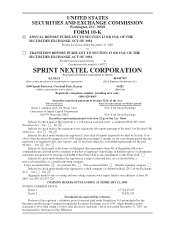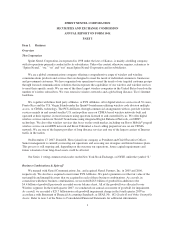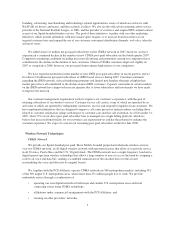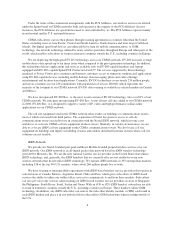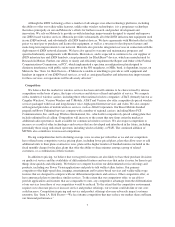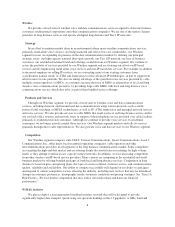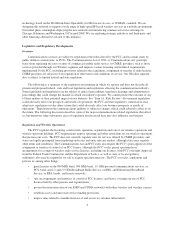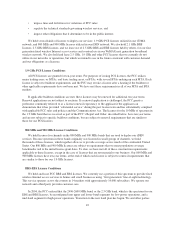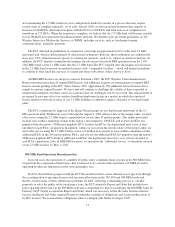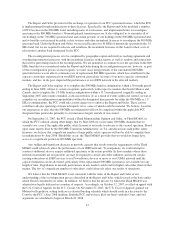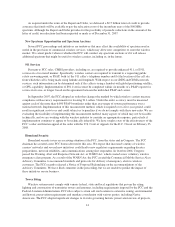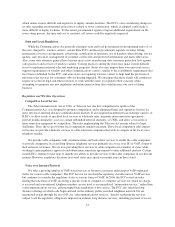Sprint - Nextel 2007 Annual Report Download - page 9
Download and view the complete annual report
Please find page 9 of the 2007 Sprint - Nextel annual report below. You can navigate through the pages in the report by either clicking on the pages listed below, or by using the keyword search tool below to find specific information within the annual report.Although the iDEN technology offers a number of advantages over other technology platforms, including
the ability to offer our walkie-talkie features, unlike other wireless technologies, it is a proprietary technology
that relies principally on our and Motorola’s efforts for further research, and product development and
innovation. We rely on Motorola to provide us with technology improvements designed to expand and improve
our iDEN-based wireless services. Motorola provides substantially all of the iDEN infrastructure equipment used
in our iDEN network, and substantially all iDEN handset devices. We have agreements with Motorola that set the
prices we must pay to purchase and license this equipment, as well as a structure to develop new features and
make long-term improvements to our network. Motorola also provides integration services in connection with the
deployment of iDEN network elements. We have also agreed to warranty and maintenance programs and
specified indemnity arrangements with Motorola. Motorola is, and is expected to continue to be, our supplier of
iDEN infrastructure and iDEN handsets, except primarily for BlackBerry®devices, which are manufactured by
Research In Motion. Further, our ability to timely and efficiently implement the Report and Order of the Federal
Communications Commission, or FCC, which implemented a spectrum reconfiguration plan designed to
eliminate interference with public safety operators in the 800 megahertz, or MHz, band, is dependent, in part, on
Motorola. See “Item 1A. Risk Factors—If Motorola is unable or unwilling to provide us with equipment and
handsets in support of our iDEN-based services, as well as anticipated handset and infrastructure improvements
for those services, our operations will be adversely affected.”
Competition
We believe that the market for wireless services has been and will continue to be characterized by intense
competition on the basis of price, the types of services and devices offered and quality of service. We compete
with a number of wireless carriers, including three other national wireless companies: AT&T (formerly known as
Cingular Wireless), Verizon Wireless and T-Mobile. AT&T and Verizon also offer competitively-priced wireless
services packaged with local and long distance voice, high-speed Internet services and video. We also compete
with regional providers of mobile wireless services, such as Alltel Corporation. Our Boost Mobile-branded
prepaid and Boost Unlimited services compete with a number of regional carriers, including Metro PCS
Communications, Inc. and Leap Wireless International, Inc., which offer competitively-priced calling plans that
include unlimited local calling. Competition will increase to the extent that new firms enter the market as
additional radio spectrum is made available for commercial wireless services. We also expect competition to
increase as a result of other technologies and services that are developed and introduced in the future, including
potentially those using unlicensed spectrum, including wireless fidelity, or WiFi. The continued addition of
MVNOs also contributes to increased competition.
Pricing competition has led to declining average voice revenue per subscriber as we and our competitors
have offered more competitive service pricing plans, including lower priced plans, plans that allow users to add
additional units to their plans at attractive rates, plans with a higher number of bundled minutes included in the
fixed monthly charge for the plan, plans that offer the ability to share minutes among a group of related
customers, or a combination of these features.
In addition to pricing, we believe that our targeted customers are also likely to base their purchase decisions
on quality of service and the availability of differentiated features and services that make it easier for them to get
things done quickly and efficiently. We believe we compete based on our differentiated service offerings and
products, including our Power Vision applications and push-to-talk walkie-talkie feature. Our primary
competitors offer high-speed data, imaging, entertainment and location-based services and walkie-talkie-type
features that are designed to compete with our differentiated products and services. Other competitors offer, or
have announced plans to introduce similar services. To the extent that our competitors offer, or are able to
provide applications and features that are comparable to ours, any competitive advantage from the differentiation
of our services from those of our competitors would be reduced. To the extent that the competitive environment
requires us to decrease prices or increase service and product offerings, our revenue could decline or our costs
could increase. Competition in pricing and service and product offerings also may adversely impact customer
retention. See “Item 1A. Risk Factors—We face intense competition that may reduce our market share and harm
our financial performance.”
7

